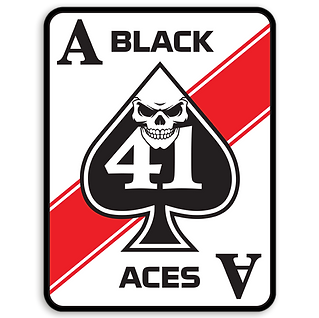
VFA-41 Black Aces
“First to Fight; First to Strike.”
The Black Aces began their legacy on September 1, 1950, entering the Jet Age with the F2H Banshee and patrolling the Mediterranean amid growing Cold War tensions. They soon upgraded to the F3H Demon, the Navy’s first jet with radar-guided missiles, and later to the legendary F-4 Phantom.
In 1962, VF-41 helped enforce the Cuban Missile Crisis blockade. Three years later, they were flying combat missions over Vietnam, where LTJG David Wheat was captured and spent over seven years as a POW—becoming a symbol of courage and resilience.
The Aces supported Middle East operations after the Yom Kippur War and transitioned to the F-14 Tomcat in the late ’70s. In 1981, they scored the Navy’s first air-to-air kills since Vietnam by downing two Libyan Su-22s. Their experience proved vital through the ‘80s and into Desert Storm, where they flew over 1,500 hours with a perfect sortie rate.
In the ‘90s, VF-41 led the way in Bosnia and Kosovo, becoming the first Tomcat squadron to drop bombs in combat. After 9/11, they were the first over Afghanistan, launching the opening strikes of Operation Enduring Freedom. Soon after, they became the Navy’s first operational F/A-18F Super Hornet squadron.
In the 2000s, VFA-41 completed combat deployments to Iraq and Afghanistan, appearing in the PBS series Carrier. Their global reach continued with operations in the Arabian Gulf, South China Sea, and support missions for Operations Enduring Freedom and Inherent Resolve.
For over 70 years, the Black Aces have been at the forefront of U.S. naval aviation—an enduring symbol of readiness, sacrifice, and excellence. Their story is woven into the very fabric of American military history.
Our version of the VFA-41 Black Aces US Navy Fighter Attack Squadron artwork, used in the F/A-18c Hornet livery:





ORIGINAL

REVISED
Please note: Featured on this site are many refreshed versions of the squadron's original emblem designs.
We've made subtle tweaks to some, more sweeping changes to others, but our intention is always to preserve the essence of the original ~ to create a slightly updated version that would print clearer on a variety of mediums.
All of our emblem design versions have been created with deep respect for the original design and their respective designers. It is our homage to these squadrons, their personnel, crews, and veterans.